thiruki@cogeco.ca |
Board |
About Japanese Coins
One side of each coin (with the exception of the 5 yen) shows the value in Arabic numerals and the year in which the coin was minted, written in kanji (Chinese characters) or a combination of kanji and Arabic numerals. The year is expressed in the gengou system, which is unique to Japan and relates years to the length of the reign of the emperor at the time. Most of the coins encountered these days are either Heisei (The Era of Achieving Peace under Akihito, emperor since 1989) or Showa (The Era of Enlightened Peace under the previous emperor, Hirohito, 64 years from 1926 to 1989).
The other side of each coin has "Country of Japan" at the top and the value written in kanji at the bottom. There is also a picture of a flower or a tree which is symbolic to the Japanese. An exception is the 10-yen coin, which shows a famous building instead. See below for details.
 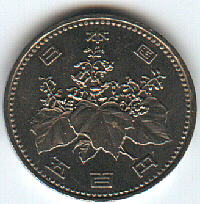 |
Composition: Cupro-nickel Design: Paulownia, Bamboo, Orange (minting halted in 1999) Wood of kiri no ki or the "Princess Tree" has been used to make everything from ceremonial masks to ohashi (chopsticks). It has a grain similar to oak, but is extremely lightweight. The trees bear purple flowers in the springtime. A 500-yen banknote also exists, but is harder to find because it is out of production. Bamboo (take) represents strength and flexibility. Oranges are a sign of rebirth.
|
  |
Composition: Nickel Brass Design: Paulownia, Bamboo, Orange (issued 01 August 2000) The size and weight of the old 500-yen coin (above) is almost the same as a Korean coin of much lower value. Problems with vending machine fraud led to the introduction of this gold-colored one, which has a different conductivity. Inside the two zeros are latent images visible only when viewing the coin at an angle. The edge has helically milled ridges to deter counterfeiting.
|
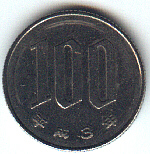  |
Composition: Cupro-nickel Design: Cherry Blossoms Is there anything more Japanese than the sakura? Japanese people love to look at cherry blossoms every spring. The flowers can be used in sweets and tea.
|
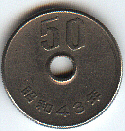  |
Composition: Cupro-nickel Design: Chrysanthemum Kiku no hana is the flower of Japan's Imperial Family. The Emperor is said to sit on "The Chrysanthemum Throne". |
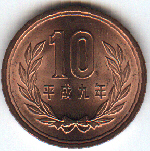 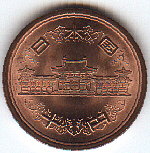 |
Composition: Bronze Design: Evergreen Tree and Uji Byodo-in Hoo-do Temple (a famous temple in Kyoto) The pine (matsu) is a divine tree representing constancy, vitality and longevity. Pine branches are an important part of the kadomatsu decoration in family homes during the New Year celebration.
|
 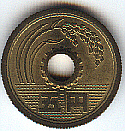 |
Composition: Brass Design: Ear of Rice, Gear, Water, Young Leaves The industrious Japanese people are powered by rice grown in water-filled tambo (paddies). "Go-en" (Japanese for "5 yen") sounds the same the word for "fate", so people keep this coin for good luck, or offer it when praying at temples and shrines. |
 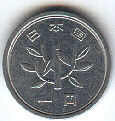 |
Composition: Aluminum Design: Young Tree
Like a young tree that becomes big, the value of even one yen can grow!
|
Links
Mint Bureau, Ministry of Finance, Government of JapanNow includes a helpful Q and A section
Japanese Currency Museum by the Bank of Japan
Japanese Currency from the Japanese Culture Center
Japanese Currency - Explanation
Oh! Retro: Holeless 50-yen Coins
Commemorative Coins in Japan
Japanese Coins History and gallery by S.A. Temeryazev in Nahodka, Russia.
He posted his own Modern Japanese Coins webpage after seeing this one. Learn some more there!
Japanese Coinage
Old Japanese Coins An image gallery by the University of Tokyo
Old Japanese Coins Images and brief descriptions
Japan 1868-1899: Building a National Currency by Joseph Boling of the American Numismatic Association
Tokyo Treasure Hunting Metal detector finds old coins ... and other things
Jeff's Metal Detecting Site
Learn about this interesting hobby
Southeast Asia Coins and Related Web Links
The Royal Canadian Mint Compare with Canuck coins
Coin Link
Joel's Coins: Unusual Coins
Odd shapes, odd sizes, design errors and other unusual stuff
E-mail me at thiruki@cogeco.ca |
| Discuss this topic on the Runker Room "Japanese Coins" Discussion Board |
View my guestbook | Sign my guestbook
 visitors since 12 July 1998
visitors since 12 July 1998
First posted 10 July 1998. Last updated 04 November 2003.
[HOME] [Japan-related Links]